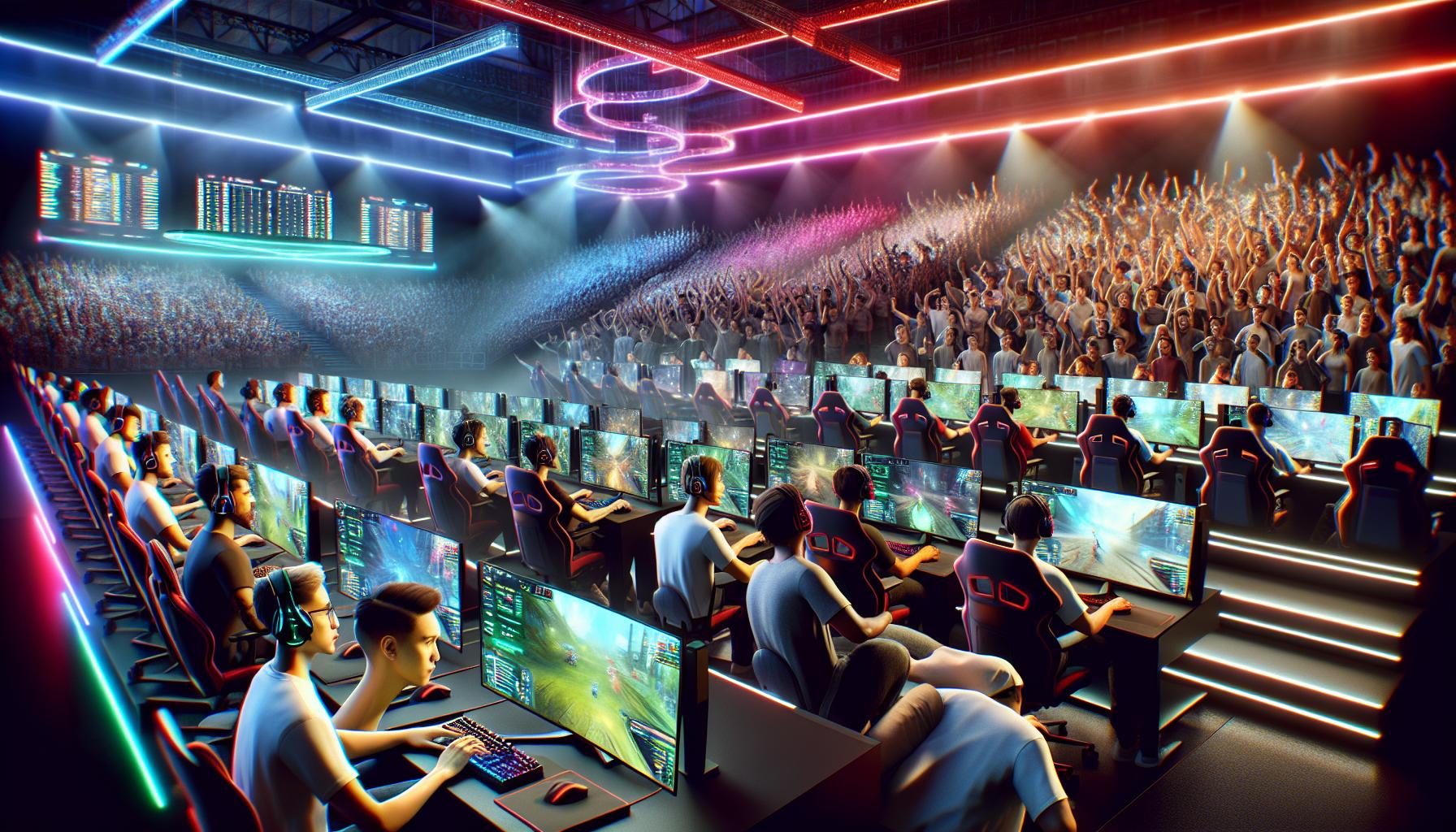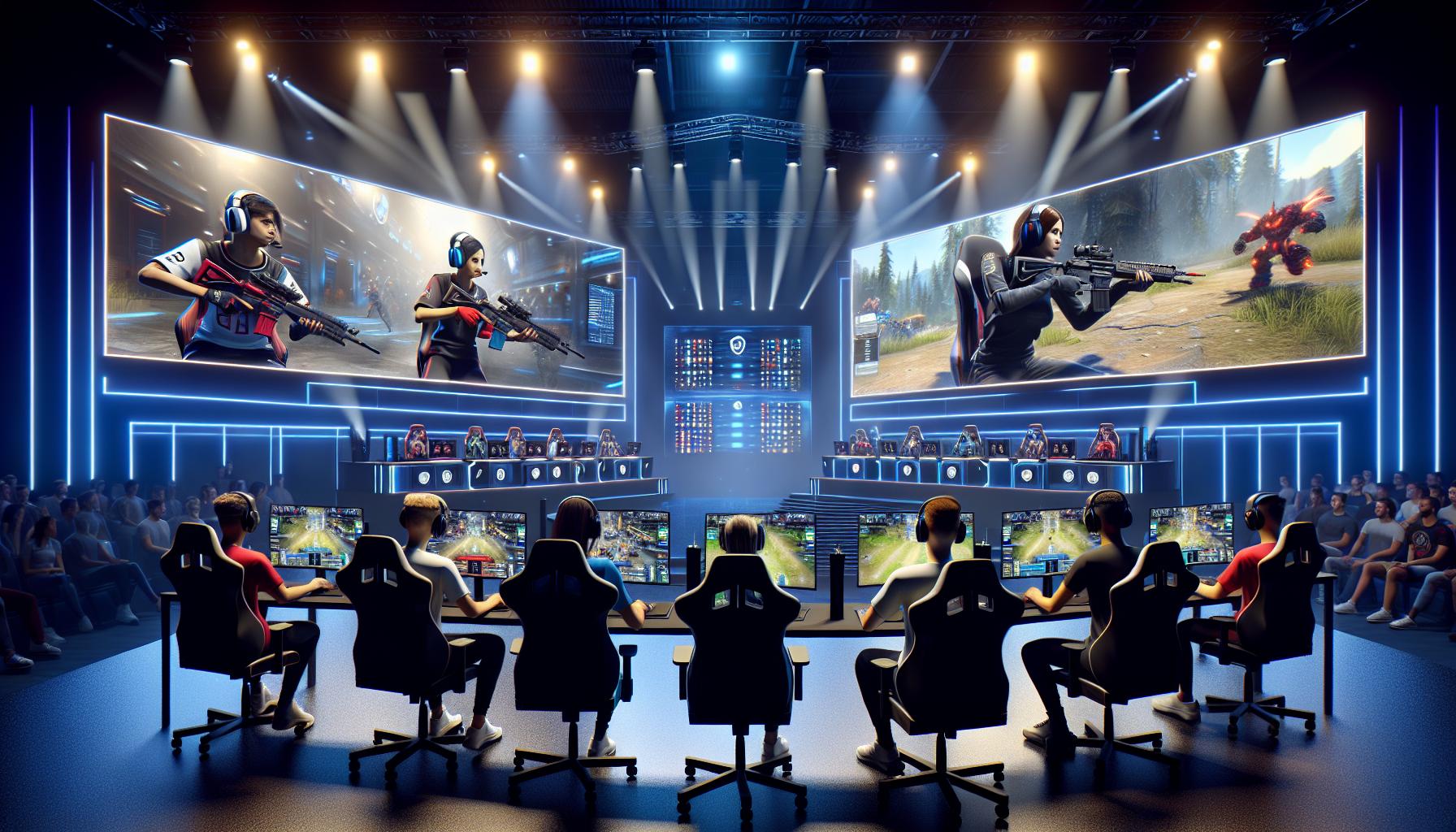Key Takeaways
- Origins of Esports: Esports originated in the early 1970s with the first competition, Spacewar!, highlighting its roots in organized gaming.
- Growth Through the Decades: The 1990s saw esports gain momentum with the rise of online multiplayer games like StarCraft, leading to the establishment of professional leagues.
- Major Tournaments: Landmark events like The International for Dota 2 and the League of Legends World Championship have significantly shaped the industry and attracted massive audiences.
- Technological Advancements: Improved internet access, streaming platforms, and advanced gaming hardware have transformed esports, enhancing competition and fan engagement.
- Influential Games: Iconic titles such as Counter-Strike and League of Legends have been pivotal in defining competitive gaming culture and expanding its popularity.
- Future of Esports: The combination of technology, innovative gameplay, and strong community engagement continues to drive the evolution of esports into a billion-dollar industry.
Esports has evolved from casual gaming into a global phenomenon, captivating millions and reshaping the entertainment landscape. As competitive gaming gains traction, understanding its history becomes essential for fans and newcomers alike. This guide delves into the milestones that have defined esports, from its humble beginnings in arcades to the high-stakes tournaments that fill stadiums today.
Players, teams, and games have played pivotal roles in this journey, each contributing to the rich tapestry of esports culture. By exploring the key events and influential figures, readers can appreciate the depth of this vibrant community. Whether you’re a seasoned veteran or just starting to explore the world of esports, this guide offers valuable insights into the game’s past and its exciting future.
Esports History Game Guide
Esports history traces back to the early 1970s with the first known video game competition. The game, Spacewar!, hosted at Stanford University, marked the beginning of organized competitive gaming. By the 1980s, arcade games like Pac-Man and Donkey Kong sparked local tournaments, raising interest across communities.
The 1990s saw significant growth in esports. The launch of consoles and PC games, such as StarCraft and Quake, introduced online multiplayer capabilities, leading to larger competitions. The Cyberathlete Professional League (CPL), established in 1997, set a precedent for professional leagues, awarding substantial cash prizes.
In the 2000s, esports gained mainstream attention. The emergence of online platforms like Major League Gaming (MLG) and the rise of streaming services offered new avenues for players and audiences. Titles like Counter-Strike and League of Legends garnered dedicated fan bases, establishing specific esports genres.
The 2010s marked a turning point, with esports integrated into major events like the X Games and the Asian Games. Sponsorships and media rights increased, elevating esports to a globally recognized industry. The successful launch of The International by Valve in 2011 demonstrated the viability of esports as a multi-million dollar enterprise.
Today, esports represents a billion-dollar industry, featuring global tournaments, professional teams, and dedicated fan engagement. The blend of technology, talent, and culture continues to shape the esports landscape, paving the way for future innovations and competitions.
Key Milestones in Esports Development

Esports has undergone significant evolution, marked by various milestones that shaped its landscape. Understanding these turning points illuminates the trajectory of competitive gaming.
Early Beginnings
Esports traces its origins to the early 1970s with the first recorded competition, Spacewar!, at Stanford University in 1972. The 1980s introduced local arcade tournaments, featuring games like Pac-Man and Donkey Kong, where players competed for high scores. By the late 1980s, the first officially recognized tournament, the Atari National Space Invaders Championship, attracted over 10,000 participants, solidifying a foundation for competitive gaming.
Rise of Competitive Gaming
The 1990s marked a pivotal era for esports with the proliferation of online multiplayer games. Titles like StarCraft and Quake became seminal, leading to the establishment of professional leagues, such as the Cyberathlete Professional League (CPL) in 1997. The emergence of these leagues facilitated structured competition and attracted dedicated players. The release of the first fully online tournament in 1999, featuring Quake III Arena, underscored the growing interest in esports and helped cultivate a community of fans and competitors alike.
Major Esports Games That Shaped the Industry

Numerous games significantly influenced the evolution of esports, each leaving a lasting impact on culture and competition. Understanding these classic and modern titles highlights the landscape of competitive gaming.
Classic Titles
Classic titles paved the way for competitive gaming, setting the stage for future developments.
- Spacewar! (1972): Considered the first-ever video game competition, it introduced competitive elements in gaming.
- Pac-Man (1980): Its arcade tournaments marked the beginning of organized competitive play, attracting thousands.
- StarCraft (1998): Launched the real-time strategy genre, fostering a robust professional scene in South Korea.
- Quake III Arena (1999): This groundbreaking shooter highlighted online multiplayer’s potential and led to the first fully online tournament.
- Counter-Strike (2000): This tactical shooter became a staple of esports, laying the groundwork for team-based competition.
Modern Games
Modern games have expanded esports’ reach and popularity, attracting diverse audiences.
- League of Legends (2009): Its franchise boasted global tournaments and established significant sponsorship deals, becoming a blockbuster title.
- Dota 2 (2013): Known for The International, this MOBA garnered record-breaking prize pools, cementing its status in competitive gaming.
- Overwatch (2016): Blending team-based play and unique characters, it introduced new dynamics in esports competition and viewer engagement.
- Fortnite (2017): With its unique appeal and massive player base, it revolutionized tournaments through accessibility and innovation.
- Valorant (2020): This tactical shooter utilizes a strategic gameplay approach and has rapidly built a vibrant competitive community.
These classic and modern titles substantially shaped esports, influencing gameplay, community, and the industry’s development.
Influential Tournaments and Events

Tournaments and events have been pivotal in shaping the esports landscape. Their evolution highlights the growth of competitive gaming, impacting player engagement and fan interest.
The Evolution of Tournaments
Tournaments evolved from small, local gatherings to large-scale events attracting global audiences. In the early stages, competitions primarily featured single titles, such as the Atari National Space Invaders Championship in 1980. The 1990s introduced structured competitions, including the Cyberathlete Professional League (CPL) in 1997, which standardized tournament formats and fostered a competitive environment.
The expansion of the internet in the 2000s facilitated the rise of online tournaments, allowing players from different regions to compete simultaneously. Major League Gaming (MLG) showcased this shift with streaming capabilities, enabling real-time participation and viewership. As esports matured, tournaments incorporated multiple titles, adopting diverse formats like leagues, round-robin play, and elimination brackets to engage broader audiences.
Landmark Championships
Landmark championships have defined esports history, spotlighting remarkable moments and fostering community growth. Notable examples include:
- The International: Launched by Valve in 2011, this Dota 2 tournament introduced substantial prize pools, reaching over $40 million in 2021. Its annual presence solidified Dota 2’s competitive ecosystem.
- League of Legends World Championship: Established in 2011, this championship attracts millions of viewers, showcasing the best teams globally. It emphasizes the game’s strategic depth and team synergy.
- Intel Extreme Masters (IEM): Inaugurated in 2006, IEM became a cornerstone of competitive gaming. The event features multiple titles and fosters international participation, drawing significant audiences in person and online.
- Overwatch League: Launched in 2018, this league set new standards for franchise-based competition in esports. Its structured format and team city representation broadened the audience base.
These championships represent milestones in esports, demonstrating its transition to a billion-dollar industry while captivating audiences worldwide through innovative formats and high-stakes competition.
Impact of Technology on Esports
Technology has significantly influenced the evolution and growth of esports. Rapid advancements in hardware and software transformed gaming experiences, leading to an increase in competitive play.
- Improved Internet Access: Enhanced Internet speeds allowed seamless online gaming, enabling real-time competition among players worldwide. The rise of high-speed broadband in the early 2000s facilitated the transition from local LAN tournaments to expansive online events.
- Streaming Platforms: Platforms like Twitch and YouTube revolutionized how esports reached audiences. Live streaming provided fans with direct access to tournaments, player interactions, and community engagement. This interaction fostered a sense of global community and increased esports visibility.
- Gaming Hardware Advancements: Innovations in gaming consoles and PCs gave players the tools needed for optimal performance. Features like advanced graphics cards and low-latency monitors enhanced gameplay experiences, contributing to higher skill levels in competitive settings.
- In-game Features: Modern games often include spectator modes, allowing viewers to experience gameplay from multiple perspectives. These features promote better understanding among fans and enhance the overall viewing experience during tournaments.
- Data Analytics: The use of data analytics and software tools has reshaped strategies in esports. Teams rely on data to analyze performance, identify opponents’ weaknesses, and refine tactics. This information-driven approach leads to improved strategies and competitive advantage.
- Social Media Engagement: Social media platforms enable real-time updates about esports events, players, and teams, fostering fan engagement. Players and organizations leverage these channels for marketing and community-building efforts.
Technology continues to shape the future of esports, driving innovation in gameplay, community interaction, and viewer experience. These advancements ensure a dynamic and evolving landscape that keeps both players and fans engaged.
Understanding This Rich History
Esports has come a long way since its humble beginnings in the 1970s. Its transformation into a multi-billion dollar industry reflects not just the evolution of games but the dedication of players and fans alike. The milestones and innovations discussed showcase how competitive gaming has become a vital part of modern entertainment.
Understanding this rich history is crucial for anyone looking to appreciate the depth of esports. As technology continues to advance and new games emerge, the future of esports promises even more excitement and opportunities. The community’s passion and engagement will undoubtedly drive this vibrant industry to new heights.